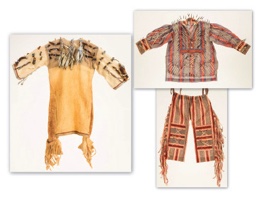Click the logo to go to the Lakota Emergence
homepage
The wonderful gifts that Anunk Ite prepared for her Pte relatives had the effect on them that she desired. They wanted more of the meat and clothing. These gifts were fascinatingly new, and so the Pte people had questions regarding their origins. But Tokahe kept his word to the wolf that he would not disclose how or from whom he received the gifts. In so doing, he positioned himself as the only Pte person with knowledge of where the gifts came from and how they could be acquired.
Like many Lakotas, Andrea Lekberg was raised in a city far from her tribe’s reservation. Her Lakota identity was rooted in the stories her grandmother told her during summer visits to Pine Ridge, and in the faint memory of a pair of moccasins that she wore as a child, made for her by Angelique Fire Thunder.
Andrea’s passage in the emergence narrative focuses on the moment that Tokahe shared the food and clothing with the people: “He and his woman wore the clothes and all the people envied them.” The passage led Andrea to think “that it wasn’t the clothes themselves that the people envied, but the ability to make the clothes.” The Pte people did not covet the clothing as Anunk Ite believed they would, but nevertheless they still wanted to come to this world to learn how to make such beautiful objects.
Starting from white British cotton fabric, Andrea fashioned the woman’s dress and then dyed it with hickory and sassafras to soften its harsh white color and texture. She adorned the dress with sage and healing herbs, and placed chokecherry patties in the pockets, representing the nurturing qualities of women. “I was thinking of my grandma, because she would always make wojapi and wasna. It was one of my favorite things about coming to see her.”
On the man’s shirt, Andrea chose a pattern from the 1870’s and laced the shirt with porcupine quills to symbolize strength and showmanship. But instead of being flattened and colored, she left the quills in their original form. Their sharp points protrude from the shirt and leggings, making handling the garments, much less wearing them, risky. “I love quillwork, but I never learned to do it,” Andrea says. “When it is beautifully done, you can’t even tell what the material is. I wanted to show what the raw material was.” In a nod to Lakota fortitude, she says, “I thought to myself, this is the kind of shirt that would be worn by a warrior!”
Tokahe showed the meat to the people. They ate of it and said it was good. He and his woman wore the clothes and all the people envied them. He told the people there were plenty of such things in the world. They asked him how they could get things like these, but he could not tell them.

